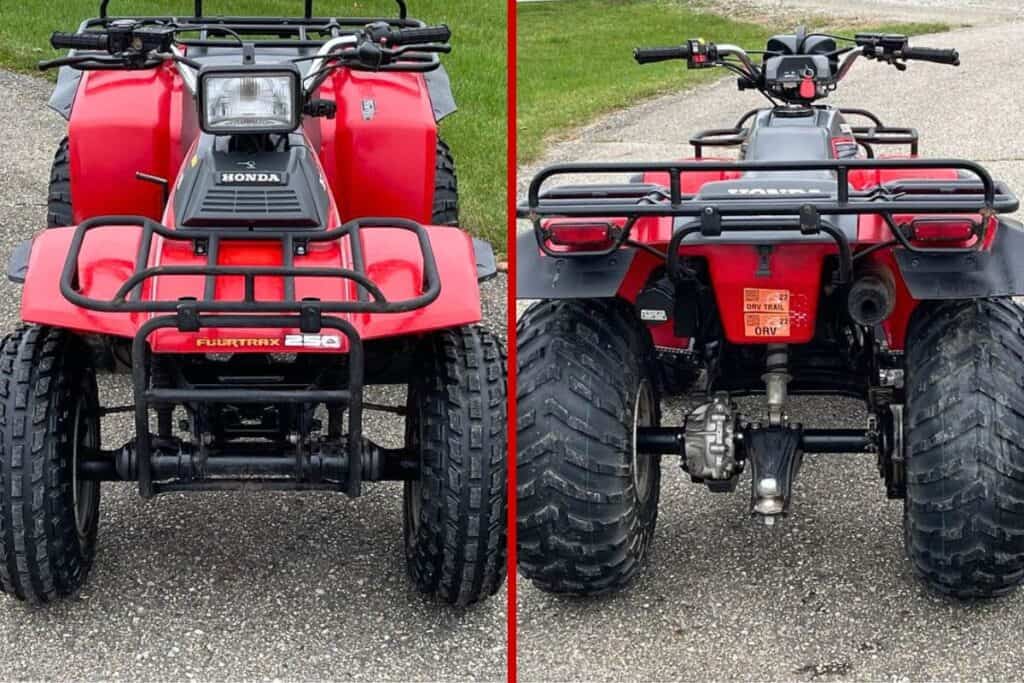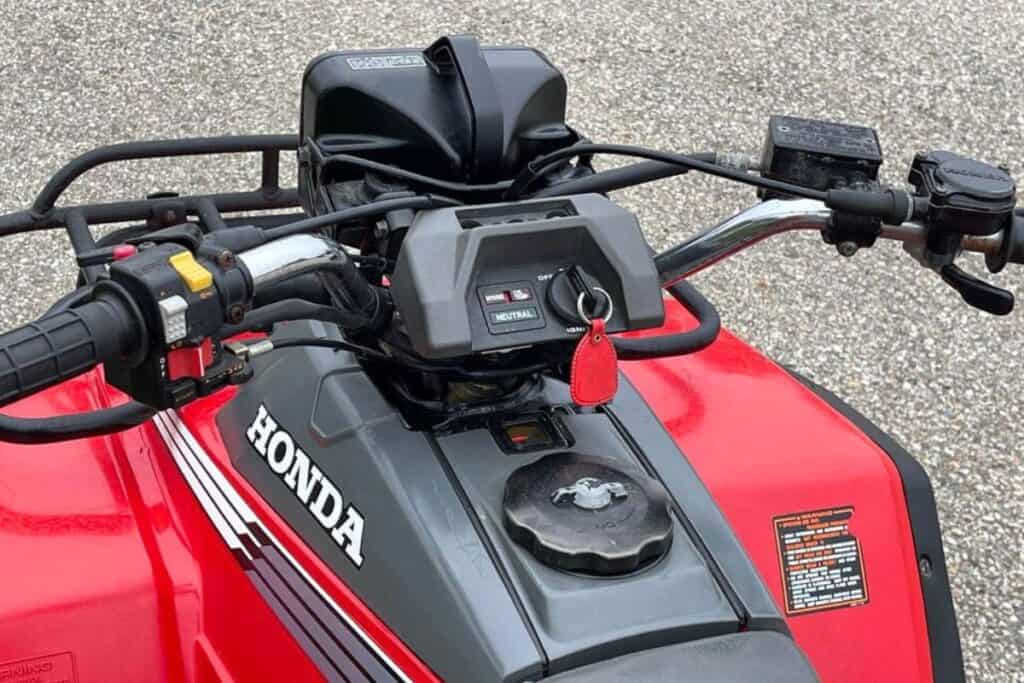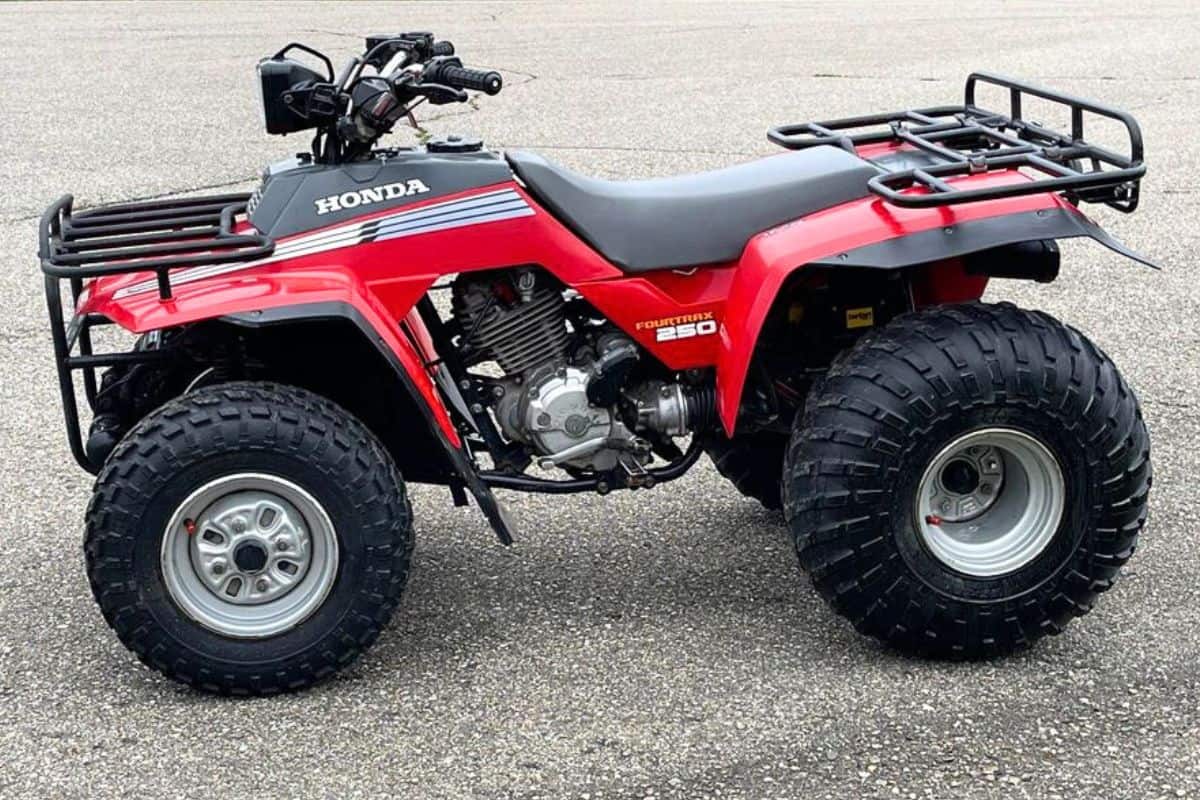The Honda FourTrax 250, also known as the Honda TRX 250, has been a favorite among off-road enthusiasts for decades.
Thanks to its reliable performance, rock-solid durability, and simple design.
Because of this, the Honda FourTrax 250 continues to be a sought-after machine even though Honda hasn’t produced the four-wheeler in over 35 years!
In fact, the Honda TRX 250’s popularity is only rivaled by the Honda FourTrax 300, which followed the 250 in 1988.
In this complete powersports vehicle guide, we’ll tackle the specs and features of the Honda FourTrax 250.
We’ll also cover everything from its engine and transmission to its top speed and pricing, as well as answer some of the most frequently asked questions about this iconic ATV.
By the end, we promise you’ll realize just why this classic utility ATV has such a die-hard following.
History & Evolution of the Honda FourTrax 250
The Honda FourTrax 250, entered the market in 1985, marking the beginning of a short but impactful production run, lasting until 1987.
Despite its relatively brief stint, the Honda 250 quickly gained a reputation as a reliable utility ATV that appealed to both farmers and ranchers as well as off-road enthusiasts.
The story of the Honda FourTrax 250 begins though with Honda’s revolutionary ATC 250R three-wheeler, which was introduced in 1981. The ATC 250R was the world’s first high-performance ATV, featuring a 248cc air-cooled two-stroke engine, a manual clutch, and a suspension system that set it apart from other ATVs at the time.
However, as the ATV industry shifted towards four-wheelers due to stability and safety concerns, Honda introduced the utility-based FourTrax 200 in 1984, utility-based FourTrax 250 in 1985, and the sport-based FourTrax 250R in 1986.
The utility-based FourTrax 250 was only produced for three years, from 1985 to 1987, before Honda replaced it with the incredibly popular Honda Fourtrax 300 in 1988, which was produced until 2000.
Although the FourTrax 250 has been out of production for over three decades, its legacy lives on, with many enthusiasts still riding and restoring these iconic machines today.
1986 Honda FourTrax 250 Specs:
How Much Does a Honda FourTrax 250 Cost?
The Honda FourTrax 250, despite being out of production for over three decades, remains a highly sought-after ATV among off-road enthusiasts and collectors.
Because of this, the prices for these machines remain relatively high despite their age.
On average, a Honda FourTrax 250 can cost anywhere from $1,500 to $3,500 depending on its condition, model year, location, and title status.
At the lower end of the price range, around $1,500, you might find a FourTrax 250 that needs significant work or restoration. These ATVs may have high mileage, missing parts, or significant cosmetic and mechanical issues.
As the condition of the ATV improves, so does the price. A FourTrax 250 in good condition, with minimal wear and tear, and no major mechanical issues, can cost between $2,000 and $3,000. These ATVs are generally well-maintained, have lower mileage, and may include some aftermarket modifications or upgrades.
At the higher end of the price range, around $3,500 or more, you’ll find FourTrax 250s in excellent or even pristine condition. These ATVs will often have very low mileage, original parts, and minimal signs of use.
It’s important to note that the prices can also be influenced by factors such as location and demand. In areas with a strong off-road culture or a high concentration of ATV enthusiasts, prices for the FourTrax 250 may be higher due to increased competition among buyers.
In addition, title status can also impact the price of a Honda TRX250, as machines with a clearly established title tend to command higher prices compared to those without proper documentation and title work.
To see how the price of the Honda FourTrax 250 compares to modern ATVs, check out our blog post “How Much Does an ATV Cost? (21 Models Compared)“
Best Places to Find a Honda TRX 250 For Sale

Because of the Honda TRX 250’s age, it can be hard to find one for sale, especially one in good condition, as many of these ATVs have been destroyed over the years or left to rot in a barn or field.
Because of this, finding a well-maintained Honda FourTrax 250 requires patience and persistence.
It’s important to keep a close eye on the various online marketplaces and be ready to act quickly when a promising listing appears.
Due to the limited supply and high demand for these vintage ATVs, desirable listings can be snatched up quickly by enthusiasts and collectors.
Below are some of the best places I’ve personally found to try and snag one of these classic off-roaders.
When searching for a Honda FourTrax 250 on any of these platforms, be sure to carefully review the listing details, including the ATV’s condition, maintenance history, and title status.
Don’t hesitate to ask the seller for additional information or photos, and always exercise caution when making a transaction, especially if you’re buying from a private party or remotely.
If it sounds too good to be true it probably is.
What’s the Difference Between the Honda FourTrax 250 & 250R?
Off-road enthusiasts often confuse the Honda FourTrax 250 and 250R, calling them by the same name or assuming they’re the same machine.
When in reality the Honda FourTrax 250 and Honda FourTrax 250R are two distinct models designed and built for two completely different riding applications.
Factors that Separate the FourTrax 250 & FourTrax 250R
Intended Use:
- The Honda FourTrax 250, was designed as a versatile, general-purpose ATV suitable for a wide range of off-road activities, including trail riding, utility tasks, and recreational riding.
- The Honda FourTrax 250R was developed specifically for racing and high-performance off-road riding. It was built to be lighter, more agile, and more powerful than the standard FourTrax 250.
Suspension:
- The Honda FourtTrax 250 featured a full-suspension system, with front and rear shocks designed to provide a comfortable and compliant ride over rough terrain.
- The Honda FourTrax 250R offered a more advanced suspension system, tuned for maximum performance, and was designed to handle the rigors of racing and aggressive off-road riding.
Performance:
- The Honda Fourtrax 250 was powered by a 246cc engine, which provided a good balance of power and reliability for general off-road use. The engine was designed to deliver a broad, usable powerband suitable for a variety of riding conditions.
- The Honda FourTrax 250R while offering the same displacement featured a higher performance engine that was tuned for maximum output. So much so that the FourTrax 250R was the fastest racing quad available at the time.
Weight and Dimensions:
- The Honda Fourtrax 250 was slightly heavier and larger than the TRX250R, reflecting its intended use as a versatile, general-purpose ATV.
- The Honda TRX250R was engineered to be lighter and more compact, contributing to its improved agility and handling on the race track.
What is the Honda FourTrax 250’s Top Speed?

The Honda FourTrax 250, offered a top speed of 45 miles per hour (72 kilometers per hour).
At a time when most ATVs were designed primarily for light-duty recreational riding, the FourTrax 250 stood out as a machine that could deliver both impressive acceleration and a top speed that rivaled some of the fastest off-road vehicles of its day.
The FourTrax 250’s engine, while tuned for reliability and usability across a wide range of off-road conditions, still managed to produce enough power to propel the ATV to speeds that were considered quite fast for the mid to late 1980s, and really even by today’s standards when you factor in its smaller displacement.
What Years Did They Make the Honda FourTrax 250?
The Honda FourTrax 250, also known as the TRX250, was a popular and influential ATV produced by Honda for a relatively short period during the mid-1980s.
Specifically, the Honda FourTrax 250 was manufactured from 1985 to 1987, with each model year bringing slight changes and improvements to the machine.
Despite its short production run, the Honda FourTrax 250 left a lasting impact on the ATV industry.
Its combination of performance, reliability, and versatility set a new standard for four-wheeled ATVs and paved the way for future generations of Honda four-wheelers and off-road vehicles.
Is the Honda TRX 250 4WD?
The Honda TRX 250, also known as the FourTrax 250, was available in both 2WD (two-wheel drive) and 4WD (four-wheel drive) configurations during its production run.
This versatility allowed the TRX 250 to cater to a wider range of riders and riding conditions.
The 2WD version of the Honda TRX 250 was the cheaper option, with power being delivered to the rear wheels only. This setup provided a more traditional ATV riding experience and was well-suited for riders who used their machines for trail riding or light-duty recreation.
On the other hand, the 4WD version of the Honda TRX 250 offered enhanced traction and stability, making it an excellent choice for riders who frequently encountered challenging terrain or adverse weather conditions.
The four-wheel drive system featured a limited-slip front differential and engaged all four wheels. Providing better grip and control in situations where extra traction was needed, such as muddy trails, steep inclines, or rocky surfaces.
Is a Honda FourTrax 250 2-stroke or 4-stroke?
The Honda FourTrax 250, was equipped with a four-stroke engine throughout its production run from 1985 to 1987.
Honda opted for the four-stroke engine configuration due to its increased fuel efficiency, lower emissions, and smoother power delivery compared to two-strokes.
The FourTrax 250’s 246cc air-cooled (liquid-cooled in 1987), four-stroke, single-cylinder engine provided a balance of performance and reliability that made it well-suited for a wide range of off-road riding applications.
Throughout the FourTrax 250’s production run, Honda continued to refine and improve the four-stroke engine, with notable changes including the switch to liquid cooling in the 1987 model year.
These improvements further enhanced the engine’s performance, efficiency, and durability, cementing the FourTrax 250’s position as a legendary ATV.
Does the Honda TRX 250 Have Reverse?
The Honda TRX 250, was equipped with a reverse gear.
The inclusion of a reverse gear was a notable feature that set the TRX 250 apart from many other ATVs of its era and added to its overall versatility and convenience.
The reverse gear on the Honda TRX 250 was integrated into the ATV’s semi-automatic transmission, which featured five forward gears, neutral, and one reverse gear.
To shift into reverse:
- Locate the parking brake lever and the small button near it.
- Press and hold the small button next to the parking brake lever.
- While holding the button, pull the parking brake lever back and down.
- This action pulls two cables that disengage the transmission.
- With the button pressed and the brake lever pulled, push the shifter lever down from neutral to engage the reverse gear.
- To shift out of reverse, simply pull the shifter lever up to return to neutral.
How Old Should You Be to Ride a Honda TRX 250?
Despite its smaller 246cc engine displacement and lower horsepower and torque ratings, the FourTrax 250 was designed and intended primarily for adult riders.
Reasons why the Honda TRX 250 should only be ridden by adult riders:
- Power and acceleration: While the TRX 250’s engine might seem modest by today’s standards, it still produces significant power and acceleration that can be challenging for younger or inexperienced riders to control safely.
- Weight and size: The FourTrax 250 is a full-sized ATV, with a weight of almost 500 pounds with fuel. This weight, combined with the vehicle’s size, can make it difficult for smaller or younger riders to handle and maneuver effectively.
- Suspension and handling: The TRX 250’s suspension system, while advanced for its time, doesn’t offer the same control and maneuverability that today’s modern four-wheelers have. The ATV’s handling characteristics also require a certain level of skill and experience to navigate safely.
Honda FourTrax 250: Walk Around & Riding
Recent Posts
Is Can-Am Better Than Polaris? This question has been debated for years, sparking intense debates in off-road communities and showrooms. As two titans in the world of ATVs and UTVs, Can-Am and...
Whether you're an adult looking for a new adventure or introducing your kids to the sport, finding the best beginner dirt bike is crucial to kick-start your off-road journey on the right...

